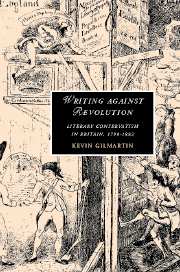Book contents
- Frontmatter
- Contents
- Illustrations
- Acknowledgments
- List of abbreviations
- Introduction: Reconsidering counterrevolutionary expression
- 1 In the theater of counterrevolution: loyalist association and vernacular address
- 2 “Study to be quiet”: Hannah More and counterrevolutionary moral reform
- 3 Reviewing subversion: the function of criticism at the present crisis
- 4 Subverting fictions: the counterrevolutionary form of the novel
- 5 Southey, Coleridge, and the end of anti-Jacobinism in Britain
- Notes
- Bibliography
- Index
- CAMBRIDGE STUDIES IN ROMANTICISM
Introduction: Reconsidering counterrevolutionary expression
Published online by Cambridge University Press: 22 September 2009
- Frontmatter
- Contents
- Illustrations
- Acknowledgments
- List of abbreviations
- Introduction: Reconsidering counterrevolutionary expression
- 1 In the theater of counterrevolution: loyalist association and vernacular address
- 2 “Study to be quiet”: Hannah More and counterrevolutionary moral reform
- 3 Reviewing subversion: the function of criticism at the present crisis
- 4 Subverting fictions: the counterrevolutionary form of the novel
- 5 Southey, Coleridge, and the end of anti-Jacobinism in Britain
- Notes
- Bibliography
- Index
- CAMBRIDGE STUDIES IN ROMANTICISM
Summary
This is a study of the literary forms and rhetorical strategies involved in British counterrevolutionary and anti-radical print expression from the first reaction to the French Revolution through the Napoleonic era to the Reform Act of 1832. The specific provisions of the 1832 bill for reform – a rationalization and limited extension of the franchise, and redistribution of parliamentary seats away from pocket boroughs in favor of populous towns and counties – by no means answered radical expectations. But taken together with a significant erosion of the constitutional position of the Church of England in the late 1820s, through the repeal of the Test and Corporation Acts and Catholic relief, electoral reform and the middle-class political ascendancy it facilitated served to shift the ideological and social terms in which a defense of the establishment was conducted over the course of the rest of the nineteenth century. While my own rationale for historical coverage has to do with developments in political expression, the years marked out for this study coincide with the notional boundaries of the British romantic period, less often insisted upon in recent literary scholarship perhaps, but still evident in a field now constituted by a critically productive tension between the old romantic canon and an influx of competing aesthetic movements and recovered writers and texts. The argument of this book is not intended to reground romanticism in conservative terms.
- Type
- Chapter
- Information
- Writing against RevolutionLiterary Conservatism in Britain, 1790–1832, pp. 1 - 18Publisher: Cambridge University PressPrint publication year: 2007

